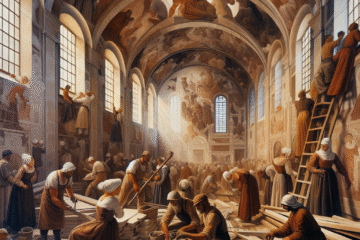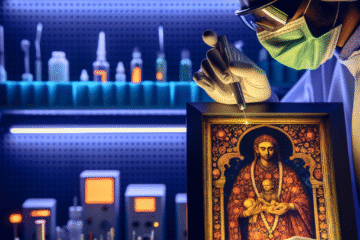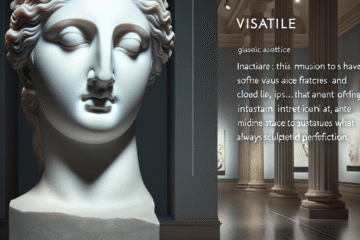I. Introduction
A. Explanation of the Purpose of the Article Art has been a reflection of the human experience for centuries, and portrait art has played a significant role in this reflection. The purpose of this article is to explore the history and evolution of portrait art, examining how it has changed and developed over time, and its impact on art and culture.
B. Brief Explanation of What Portrait Art Is Portrait art is a form of art that seeks to capture the likeness, character, and personality of a person or a group of people. It can be done using various media such as painting, drawing, sculpture, and photography. Portraiture has been an important aspect of art throughout history, and it remains a significant art form today.
C. Thesis Statement Outlining the Main Points of the Article This article will examine the history and evolution of portrait art, focusing on four main eras: early portraiture, Renaissance portraiture, the golden age of portraiture, and modern and contemporary portraiture. The first section will explore the origins of portraiture and how it reflected social hierarchies and power dynamics. The second section will examine the rise of individualism during the Renaissance and how it impacted portraiture. The third section will examine the 17th and 18th centuries as the golden age of portraiture, where portraiture became a popular art form. Finally, the fourth section will look at modern and contemporary portraiture, exploring how portraiture has evolved with the rise of photography and other media.
Throughout this article, we will examine some of the most famous and influential portrait artists of each era, including Leonardo da Vinci, Anthony van Dyck, Frida Kahlo, and Chuck Close, and we will look at some of the most famous and influential portraits in history, including the Mona Lisa, the Las Meninas, and Andy Warhol’s Marilyn Monroe. By exploring the history and evolution of portrait art, we can gain a deeper understanding of how art reflects our humanity and how we can continue to use this art form to tell our stories in new and exciting ways.
II. Early Portraiture
A. Explanation of Early Forms of Portraiture The origins of portrait art can be traced back to prehistoric times when humans created cave paintings and other forms of art to represent themselves and their world. In Ancient Egypt, portrait art was created to depict the pharaohs and their families. In early forms of portrait art, the goal was to represent the individual as accurately as possible. These early portraits often depicted the individual from the front, with little emphasis on personal expression or individuality.
B. Discussion of How Early Portrait Art Reflected Social Hierarchies and Power Dynamics Early portrait art often reflected the social hierarchies and power dynamics of the time. In Ancient Egypt, for example, portraits of the pharaohs and their families were created to depict them as powerful and divine figures. The individuals were often portrayed with stylized features that emphasized their power and importance. Similarly, in ancient Greece, portrait art was used to represent the elite members of society, such as aristocrats and athletes, and was often used to reinforce social hierarchies and power structures.
C. Examples of Early Portrait Art, Including Famous Examples Such as the Fayum Mummy Portraits One of the most famous examples of early portrait art is the Fayum mummy portraits, which were created in Ancient Egypt during the Roman period. These portraits were created to be placed over the face of the deceased person during the mummification process. The portraits were highly realistic and were created using encaustic painting techniques. The individuals depicted in the portraits were often members of the upper class and were portrayed with idealized features that emphasized their status and importance.
Another famous example of early portrait art is the bust of Nefertiti, which was created during the Amarna period of Ancient Egypt. This sculpture depicts the queen with highly stylized features that emphasize her beauty and power. The sculpture is a reflection of the social and cultural norms of the time, which emphasized the importance of beauty and physical perfection.
In conclusion, early portraiture reflects the social hierarchies and power dynamics of the time, with the goal of accurately representing the individual as accurately as possible. These early portraits often depicted individuals from the front, with little emphasis on personal expression or individuality. Examples such as the Fayum mummy portraits and the bust of Nefertiti are some of the most famous examples of early portrait art, showcasing the development of this art form over time.
III. Renaissance Portraiture
A. Discussion of the Rise of Individualism During the Renaissance and How It Impacted Portraiture The Renaissance was a time of great change and progress, and this was reflected in the art of the time. The rise of individualism during the Renaissance had a significant impact on portraiture. Portraits during this time were no longer just representations of the individual, but they also aimed to capture the individual’s personality, emotions, and inner thoughts. This focus on individuality and personality led to the development of new techniques and styles, such as the use of perspective, lighting, and shadow, which added depth and realism to portraits.
B. Overview of Famous Renaissance Portrait Artists, Such as Leonardo da Vinci and Raphael During the Renaissance, many famous artists produced portraits that remain influential today. Leonardo da Vinci is perhaps the most well-known portrait artist of the time, and his most famous portrait, the Mona Lisa, remains an iconic work of art. The painting is notable for its use of sfumato, a technique that creates a subtle, almost imperceptible blending of colors, which gives the painting a sense of depth and realism. Other famous portrait artists from the Renaissance include Raphael, who produced many famous portraits, such as the Portrait of a Young Man, and Hans Holbein the Younger, who created the famous portrait of Henry VIII.
C. Examples of Famous Renaissance Portraits, Such as the Mona Lisa and the Portrait of a Young Man The Mona Lisa is perhaps the most famous portrait in the world and is a masterpiece of Renaissance art. The painting is believed to have been created between 1503 and 1506 and depicts a woman with a mysterious smile. The painting is notable for its use of perspective and sfumato, which give the painting a sense of depth and realism.
Another famous portrait from the Renaissance is the Portrait of a Young Man, which was created by Raphael in the early 16th century. The painting is notable for its use of lighting and shadow, which create a sense of depth and texture. The painting also captures the individual’s personality and inner thoughts, with the young man appearing contemplative and thoughtful.
In conclusion, Renaissance portraiture was characterized by a focus on individuality and personality, which led to the development of new techniques and styles, such as the use of perspective and lighting. Famous portrait artists from the time, such as Leonardo da Vinci and Raphael, created some of the most influential portraits in art history, including the Mona Lisa and the Portrait of a Young Man. These portraits remain influential today and showcase the development of this art form during the Renaissance.
IV. Golden Age of Portraiture
A. Explanation of the Rise of Portraiture as a Popular Art Form in the 17th and 18th Centuries During the 17th and 18th centuries, portraiture became an increasingly popular art form. This was due in part to the rise of the middle class, who had the resources to commission portraits of themselves and their families. Portraiture also became a way for wealthy and influential individuals to assert their status and power, and for artists to showcase their skills and creativity. As a result, many famous artists during this time period produced some of the most influential portraits in art history.
B. Overview of Famous Portrait Artists from This Time Period, Such as Anthony van Dyck and Joshua Reynolds One of the most famous portrait artists from the 17th century was Anthony van Dyck, who was a court painter to King Charles I of England. Van Dyck is known for his elegant and refined portraits, which captured the grace and beauty of his subjects. Joshua Reynolds was another famous portrait artist from the 18th century, who was known for his skill in capturing the personality and character of his subjects. Reynolds was the first president of the Royal Academy of Arts in London, and his influence on the art world was significant.
C. Examples of Famous Portraits from This Time Period, Such as the Las Meninas and the Blue Boy The 17th and 18th centuries produced some of the most famous and influential portraits in art history. One of the most famous portraits from this time period is Las Meninas by Diego Velázquez, which was painted in 1656. The painting depicts the Spanish royal family, and is notable for its use of perspective and composition, which make the viewer feel as though they are part of the scene. Another famous portrait from this time period is the Blue Boy by Thomas Gainsborough, which was painted in the 18th century. The painting is notable for its use of color and composition, and for the expression of the subject, who appears confident and proud.
In conclusion, the 17th and 18th centuries were a golden age of portraiture, where the rise of the middle class and the desire for wealthy and influential individuals to assert their status and power led to an increase in the popularity of portraiture. Famous portrait artists from this time period, such as Anthony van Dyck and Joshua Reynolds, produced some of the most influential portraits in art history, and famous portraits from this time period, such as Las Meninas and the Blue Boy, remain influential today.
V. Modern and Contemporary Portraiture
A. Discussion of How Portraiture Has Evolved in the Modern Era, with the Rise of Photography and Other Media In the modern era, portraiture has evolved with the rise of photography and other media. With the advent of photography, the goal of portraiture shifted from capturing an accurate likeness of the individual to capturing a moment in time. Photography allowed for greater speed and efficiency in the creation of portraits, and it also allowed for greater experimentation with composition and style. Other media, such as digital art and mixed media, have also allowed for greater experimentation with portraiture, with artists using a variety of techniques and materials to create their works.
B. Overview of Famous Modern and Contemporary Portrait Artists, Such as Frida Kahlo and Chuck Close In the modern and contemporary era, many famous artists have continued to produce influential portraits. Frida Kahlo, for example, is known for her self-portraits that capture her physical and emotional pain, and for her use of surrealism and symbolism in her work. Chuck Close is another famous portrait artist, who is known for his large-scale portraits that use a grid system to create photorealistic images. Close’s portraits often reveal the individual’s imperfections and idiosyncrasies, and his style has been influential on many contemporary portrait artists.
C. Examples of Famous Modern and Contemporary Portraits, Such as Andy Warhol’s Marilyn Monroe and Shepard Fairey’s Obama Hope Poster One of the most famous modern portraits is Andy Warhol’s Marilyn Monroe, which was created in 1962. The painting is notable for its use of vibrant colors and repeated images of Monroe, which create a sense of both celebrity and repetition. The painting is a reflection of the mass media and celebrity culture of the time.
Another famous contemporary portrait is Shepard Fairey’s Obama Hope poster, which was created in 2008. The poster is notable for its use of bold colors and graphic design, and for its message of hope and change. The poster became an iconic image of the Obama campaign, and its style has influenced many contemporary portrait artists.
In conclusion, modern and contemporary portraiture has evolved with the rise of photography and other media, allowing for greater experimentation with composition and style. Famous modern and contemporary portrait artists, such as Frida Kahlo and Chuck Close, have continued to produce influential works, and famous portraits from this time period, such as Andy Warhol’s Marilyn Monroe and Shepard Fairey’s Obama Hope poster, remain influential today. These portraits showcase the evolution of portraiture as an art form, and its continuing relevance and importance in contemporary culture.
VI. Conclusion
A. Summary of the Main Points of the Article This article has explored the history and evolution of portrait art, examining how it has changed and developed over time, and its impact on art and culture. We began by looking at early forms of portraiture, such as cave paintings and Egyptian art, and how they reflected social hierarchies and power dynamics. We then examined how the rise of individualism during the Renaissance impacted portraiture and how it developed new techniques and styles. We then looked at the 17th and 18th centuries as the golden age of portraiture, where portraiture became a popular art form. Finally, we explored how portraiture has evolved in the modern era with the rise of photography and other media, allowing for greater experimentation with composition and style.
B. Reflection on the Evolution of Portraiture as an Art Form Throughout history, portraiture has been an important aspect of art, reflecting the human experience and our relationship with power, status, and individuality. The evolution of portraiture has been influenced by cultural, social, and technological changes, and has resulted in the development of new techniques and styles that have had a significant impact on the art world. From the highly stylized portraits of Ancient Egypt to the photorealistic portraits of Chuck Close, portraiture has evolved to reflect changing artistic and cultural trends.
C. Call to Action or Further Reflection on the Importance of Portraiture in Art and Culture Portraiture continues to be an important aspect of art and culture, allowing us to reflect on our humanity and the world around us. Through portraits, we can explore the diversity and complexity of human experience, and understand the historical, cultural, and social contexts in which they were created. As we move into the future, it is important to continue to explore and experiment with this art form, pushing its boundaries and expanding our understanding of the human experience.
In conclusion, the history and evolution of portrait art is a reflection of the human experience and our relationship with power, status, and individuality. The development of new techniques and styles has had a significant impact on the art world, and the importance of portraiture in art and culture continues to be relevant today. It is up to us to continue to explore and experiment with this art form, using it to tell our stories and reflect on the world around us.


